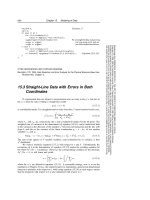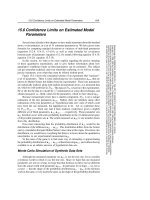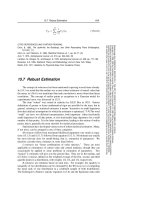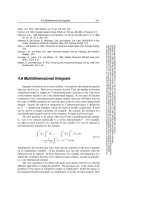Tài liệu Principles of European Constitutional Law ppt
Bạn đang xem bản rút gọn của tài liệu. Xem và tải ngay bản đầy đủ của tài liệu tại đây (3 MB, 910 trang )
PRINCIPLES OF EUROPEAN CONSTITUTIONAL LAW
While politics wrestles with the Constitutional Treaty, this volume presents
a European constitutional law—not as a mere project but as binding law.
There are good reasons to treat the European Union’s current primary law
as constitutional law: it establishes public power, legitimates legal acts, pro-
vides a citizenship, protects fundamental rights, and regulates the rela-
tionships among legal orders as well as between law and politics.
Reconstructing primary law as constitutional law yields useful insights, as
this volume seeks to demonstrate.
This volume presents European constitutional law as it stands and, on
that foundation, the Treaty establishing a Constitution for Europe. The
contributions present its theoretical and doctrinal fundamentals from the
perspective of German-speaking scholarship, reflect the state of research,
clarify methodological approaches, illuminate legal doctrines and assump-
tions, and identify research desiderata. The perspectives on offer are not
uniform, but encompass varying methodologies and differing political
approaches to integration.
Volume 8 in the Series Modern Studies in European Law
Modern Studies in European Law
1 Soft Law in European Community Law Linda Senden
2 The Impact of European Rights on National Legal Cultures Miriam Aziz
3 Partnership Rights, Free Movement and EU Law Helen Toner
4 National Remedies Before the Court of Justice Michael Dougan
5 The National Courts Mandate in the European Constitution Monica Claes
6 EU Environmental Law Maria Lee
7 European Union Law and Defence Integration Martin Trybus
8 Principles of European Constitutional Law Armin von Bogdandy and
Jürgen Bast
Principles of European
Constitutional Law
Edited by
Armin von Bogdandy
and
Jürgen Bast
Max Planck Institute for Comparative Public Law and
International Law
OXFORD AND PORTLAND, OREGON
2006
Published in North America (US and Canada)
by Hart Publishing
c/o International Specialized Book Services
920 NE 58th Avenue, Suite 300
Portland, OR 97213-3786
USA
Tel: +1 503 287 3093 or toll-free: (1) 800 944 6190
Fax: +1 503 280 8832
E-mail:
Web Site: www.isbs.com
© The editors and contributors jointly and severally 2006
The editors and contributors have asserted their right under the Copyright, Designs and
Patents Act 1988, to be identified as the authors of this work.
All rights reserved. No part of this publication may be reproduced, stored in a retrieval sys-
tem, or transmitted, in any form or by any mean, without the prior permission of Hart
Publishing, or as expressly permitted by law or under the terms agreed with the appropriate
reprographic rights organisation. Enquiries concerning reproduction which may not be cov-
ered by the above should be addressed to Hart Publishing at the address below.
Hart Publishing, Salter’s Boatyard, Folly Bridge, Abingdon Rd,
Oxford, OX1 4LB
email:
Telephone: +44 (0)1865 245533 Fax: +44 (0) 1865 794882
WEBSITE: http//:www.hartpub.co.uk
British Library Cataloguing in Publication Data
Data Available
ISBN-13: 978-1-84113-464-2 (hardback)
ISBN-10: 1-84113-464-3 (hardback)
Typeset by Compuscript, Shannon
Printed and bound in Great Britain by
TJ International, Padstow, Cornwall
Preface
W
HILE POLITICS WRESTLES with the Constitutional Treaty as the
founding legal document de lege ferenda, this volume presents a
European constitutional law—not as a mere project but as binding,
valid law, as lex lata. Of course, no document in force carries this designa-
tion. Scholarly terminology, however, does not require the blessing of poli-
tics. There are good reasons to treat the European Union’s current primary
law as constitutional law. After all, it establishes public power, legitimates
legal acts, provides a citizenship, protects fundamental rights, and regulates
the relationships among legal orders as well as between law and politics.
Constitutional law is conceivable without a state, a nation, or an instrument
that fulfils all the traditional requirements of a constitution. Reconstructing
primary law as constitutional law yields useful insights, as this volume seeks
to demonstrate. Such an endeavour does not imply a justification of primary
law in force—rather, both achievements and deficits become apparent.
This volume presents European constitutional law as it stands and, on
that foundation, the Draft Treaty establishing a Constitution for Europe as
agreed upon by the European Convention (CONV 850/03 of 18 July 2003,
hereinafter CT-Conv) as well as the Treaty establishing a Constitution for
Europe finally adopted by the ensuing Intergovernmental Conference (CIG
87/04 of 6 August 2004, hereinafter CT-IGC). The work on the chapters
was finalised in October 2004, the book reflects the European state of
affairs of that time. The contributions present the theoretical and dogmat-
ic fundamentals of European constitutional law from the perspective of
German-speaking scholarship, reflect the state of research, clarify method-
ological approaches, illuminate legal doctrines and assumptions, and iden-
tify research desiderata. This volume brings together authors of varying
methodologies and differing political approaches to integration; they are
united by the desire to protect—and even to develop further—the existing
constitutional culture within the Union.
This project is deeply indebted to the Fritz Thyssen Stiftung, which gen-
erously financed the extensive collaboration of the authors. Stephan Bitter,
Andreas Magnusson, Julia Schwartz, Michael Rötting, Robert Stelzer,
Markus Wagner, and Joseph Windsor provided valuable assistance in the
completion of the volume.
Preface v
Contents ix
Table of Cases xxxi
Table of European Founding Treaties xlix
Table of National Constitutions lxv
Table of Legislation lxxi
Table of International Treaties and Conventions lxxv
I Defining the Field of European Constitutional Law 1
1 Armin von Bogdandy: Constitutional Principles 3
2 Stefan Oeter: Federalism and Democracy 53
3 Christoph Grabenwarter: National Constitutional Law
Relating to the European Union 95
4 Robert Uerpmann-Wittzack: The Constitutional Role of
Multilateral Treaty Systems 145
5 Christoph Möllers: Pouvoir Constituant—Constitution—
Constitutionalisation 183
II Institutional Issues 227
6 Philipp Dann: The Political Institutions 229
7 Franz C Mayer: The European Constitution and the Courts 281
8 Armin von Bogdandy and Jürgen Bast: The Vertical Order of
Competences 335
9 Jürgen Bast: Legal Instruments 373
10 Antje Wiener: Soft Institutions 419
III Individual Rights 451
11 Stefan Kadelbach: Union Citizenship 453
12 Jürgen Kühling: Fundamental Rights 501
13 Thorsten Kingreen: Fundamental Freedoms 549
IV Constitutional Aspects of Economic Law 585
14 Armin Hatje: The Economic Constitution 587
15 Josef Drexl: Competition Law as Part of the European
Constitution 633
V On Finality: Contending Legal Visions 675
16 Ulrich Everling: The European Union Between Community and
National Policies and Legal Orders 677
17 Ulrich Haltern: On Finality 727
18 Paul Kirchhof: The Legal Structure of the European Union as a
Union of States 765
19 Manfred Zuleeg: The Advantages of the European
Constitution—A German Perspective 803
Index 827
viii Summary of Contents
Contents
Preface v
Table of Cases xxxi
Table of European Founding Treaties xlix
Table of National Constitutions lxv
Table of Legislation lxxi
Table of International Treaties and Conventions lxxv
I Defining the Field of European Constitutional Law 1
1 Armin von Bogdandy: Constitutional Principles 3
I. A THEORY OF A DOCTRINE OF PRINCIPLES 3
1. Principles and Constitutional Scholarship 3
2. Functions of a Doctrine of Principles 5
3. Integration as a Formation of Principles 7
II. GENERAL ISSUES OF A EUROPEAN DOCTRINE OF PRINCIPLES
8
1. The Subject Matter 8
2. National and Supranational Principles: On the Question
of Transferability 9
3. Constitutional Principles in View of Varying Sectoral
Provisions 11
III. FOUNDING PRINCIPLES OF SUPRANATIONAL AUTHORITY 12
1. Equal Liberty 12
2. The Rule of Law 15
a) A Community of Law 15
b) Principles of Protection for the Individual and of
Rational Procedure 18
3. Democracy 20
a) Development and Basic Features 20
b) The Principle of Democracy and the Institutional
Structure 25
c) Transparency, Participation, Deliberation and
Flexibility 27
d) Supranational Democracy: An Evaluation 30
4. Solidarity 32
IV. THE FEDERAL BALANCE BETWEEN UNITY AND DIVERSITY 34
1. Diversity in a System of Complementary Constitutions 34
2. Principles Promoting Unity 36
a) Realisation of Goals or Integration tout
court? 36
b) Structural Compatibility or Outright Homogeneity? 38
c) Supranationality? 40
d) The Single and Primary Legal Order 41
3. Principles Protecting Diversity 42
a) Doctrine of Competences 43
b) A General Principle of Diversity? 45
c) Protection of Diversity Through Organisation and
Procedure 46
4. The Principle of Loyalty and the Federal Balance 49
V. CONCLUDING REMARKS 51
2 Stefan Oeter: Federalism and Democracy 53
I. INTRODUCTION: “UNDERSTANDING THE EUROPEAN
UNION AS A FEDERAL POLITY”
53
II. THE DIFFERENT FEDERALISM DISCOURSES—AN OUTLINE 56
III. THE EUROPEAN UNION AS A MIXED SYSTEM OF A
FEDERATIVE CHARACTER
59
IV. THE BENEFIT OF FEDERAL ANALOGIES—OR: THE CENTRAL
STATE AS A “LEITMOTIV” OF POLITICAL THEORY
62
1. The Question of Sovereignty 63
2. “Divided Sovereignty” and the Principle of People’s
Sovereignty 65
3. People’s Sovereignty and the “Constitution” of
the European Union 67
V. THE ROLE OF THE PRINCIPLE OF DEMOCRACY IN A
FEDERAL COMMONWEALTH
72
VI. THE CONSTRUCTION OF DEMOCRATIC RESPONSIBILITY—
EXPERIENCES OF FEDERAL SYSTEMS
77
VII. THE UNITED EUROPE AS A FEDERAL SYSTEM—WHERE DOES
THE FEDERAL “STAATSVOLK” COME FROM?
83
VIII. CONCLUSIONS: THE FEDERAL “UNION” AS A PROMISING
CONSTRUCTION
85
3 Christoph Grabenwarter: National Constitutional Law
Relating to the European Union 95
I. INTRODUCTION 95
II. THE RELATIONSHIP BETWEEN UNION LAW AND NATIONAL
CONSTITUTIONAL LAW
96
1. Full Primacy of Community Law 97
x Contents
2. Limited Primacy of Community Law over Constitutional
Law 98
3. Primacy of the Constitution 103
4. The Situation in the Legal Systems of New
Member States 104
5. Similarities and Differences in Justifications 105
6. The Legal Situation According to the Constitutional
Treaty 106
III. CONTENTS OF NATIONAL CONSTITUTIONAL LAW
RELATING TO THE EUROPEAN UNION
107
1. Sovereignty and Transfer of Sovereign Rights 108
2. Structural Safeguard Clauses 112
3. Federal and Decentralised Entities 115
4. The Position of National Parliaments 122
5. Fundamental Rights 127
a) Expanding the Scope of National Guarantees of
Fundamental Rights Demanded by Community Law:
The Example of the Right to Vote in Municipal
Elections 127
b) Increased Protection of Fundamental Rights within the
Scope of Community Law: The Example of Equal
Treatment of Men and Women 130
c) Reinforcing and Changing the Effect of the European
Convention on Human Rights in the National Area 132
d) Indirect Effects of Community Law on the Scope of
National Guarantees of Fundamental Rights 133
e) Matching National Fundamental Rights with
Increased Standards at European Level 136
IV. CONCLUSIONS: RELATIONSHIP BETWEEN
NATIONAL CONSTITUTIONAL LAW AND
UNION LAW
137
1. Bodies Acting under the Constitutional Order 137
2. Interdependencies Between the Constitutional Orders of
Member States 139
3. Typology According to Substantive Orientation:
Adaptations Which are Receptive and Defensive Towards
Integration 141
4. Development Towards a Reciprocal Linking of
Constitutions 142
4 Robert Uerpmann-Wittzack: The Constitutional Role of
Multilateral Treaty Systems 145
I. A CONSTITUTIONAL QUESTION: THE EXPOSURE OF A
LEGAL ORDER TO INTERNATIONAL LAW
145
Contents xi
II. ACCESSION 149
1. WTO 149
a) Art 300(7) EC as a Starting Point 150
b) The Theory of Direct Effect 151
c) Interconnecting Different Jurisdictions 154
d) The Principle of Reciprocity 156
e) Unilateral Council Action 159
f) Internal Effect Short of Direct Effect 160
g) Monism and Dualism Revisited 162
2. ECHR 164
III. LEGAL SUCCESSION BY VIRTUE OF FUNCTIONAL
SUCCESSION
166
1. Legal Succession in International Law 166
a) GATT 1947 166
b) ECHR 167
aa) The Member States’ Responsibility to Guarantee
the Observance of Human Rights by the European
Community 167
bb) Legal Succession in a Narrower Sense 168
cc) Direct Responsibility of EC Member States 169
2. Legal Succession under Community Law 171
IV. EXPRESS INCORPORATION IN PRIMARY LAW—IN
PARTICULAR ART 6(2) EU
172
V. GENERAL PRINCIPLES OF LAW 174
VI. ASSESSMENT AND PERSPECTIVES 175
1. The Status Quo 175
2. Constitutional Perspectives 178
a) The Constitutional Treaty 178
b) Anticipating the Constitution 180
5 Christoph Möllers: Pouvoir Constituant—Constitution—
Constitutionalisation 183
I. CONSTITUTIONAL RHETORIC: LEVELS OF MEANING
183
II. THEORETICAL PREREQUISITES: TWO TYPES OF
CONSTITUTIONS 184
1. Founding of a New Order: Constitution as Politicisation
of Law 185
a) Foundation of a New Political Order 185
b) Normativity, Supremacy and Written Form of the
Constitution 187
c) Result 188
2. Shaping of the Powers: Constitution as Juridification of
Politics 188
a) Limiting Powers by Legalisation of Government 189
b) Restricted Normativity of the Constitution 190
xii Contents
c) Result 191
d) In Particular: Constitutional Treaties 192
3. The Traditions Correlated: Constitution as Coupling of
Politics and Law 193
III. BASIC POSITIONS IN THE CONSTITUTIONAL
DISCUSSION—A CRITICAL INVENTORY
194
1. Assignment of the Constitution to the Nation-State 195
2. Constitutional Elements—Constitutional Functions 196
3. Heteronomy or Autonomy of EU Law 199
4. Limited Relevance of the Discussion Fronts 202
IV. THREE CONCEPTS OF THE CONSTITUTION IN EUROPE 202
1. Pouvouir Constituant—the Criterion for Equal Freedom 203
2. Constitution: The European Treaties as a Formal
Constitution for the Union 208
a) The Treaties in Written Form 209
b) Supremacy of the Treaties 212
aa) Constitution as a Legal Argument—the ECJ and
Hierarchies within the Treaties 212
bb) Supremacy of the Treaty Law 213
c) The Treaties as a Formal Constitution: Supranational
Over-juridification and Intergovernmental
Politicisation 215
3. Constitutionalisation 215
a) Common European Constitutional Law—Establishing
Principles 217
b) Charter of Fundamental Rights 218
c) Administrative Constitutionalisation 218
d) The Legitimacy of Evolutionary
Constitutionalisation 220
V. EUROPEAN CONSTITUTIONAL LAW—A LEGAL FIELD
AND ITS ACADEMIA
220
VI. EPILOGUE: THE CONSTITUTIONAL TREATY 223
1. Constitutional Deliberation: Convention and
Intergovernmentalism 223
2. Constitutional Moments: The Political Remaining
Outside 224
3. Constitutional Honesty: The Constitutional Treaty as a
Semantic Constitution 226
II Institutional Issues 227
6 Philipp Dann: The Political Institutions 229
I. INTRODUCTION AND PURPOSE 229
II. PAST RESEARCH AND RECURRENT QUESTIONS 231
Contents xiii
1. To Council and Commission Through Principles and
Procedures 231
2. European Parliament: the Pet Object 234
3. Changing Tides: Institutional Research in the 1990s 235
III. CONCEPTUAL FRAMEWORK: THE SYSTEM OF EXECUTIVE
FEDERALISM
237
IV. THE INSTITUTIONAL SETTING 239
1. Council of Ministers 239
a) Form Follows Function: Members, Organisation and
Competences 239
b) Mode of Decision-taking: Consensus and its
Reasons 243
2. European Parliament 245
a) Co-Elector: Appointment Power and Negative
Competence 247
b) Oversight Function: Control via Organisation 250
c) Co-Legislator: Law-making by Co-operation and
Consensus-building 252
3. European Commission 255
a) The Problem of Leadership 255
b) Organisational Structure: the Outlook of a Consensual
Government 256
c) Functions: Agenda-setter, Mediator and Guardian 257
aa) Agenda Setting 258
bb) Mediating Interests 258
cc) Federal Voice and Guardian 259
d) Conclusion and an Unresolved Problem of
Leadership 260
4. European Council 261
a) Composition and Form: The Ideal of the “Fireside
Chat” 261
b) Functions 263
aa) Steering Committee 264
bb) Final Arbiter and Co-ordinator 264
cc) Treaty Negotiator and Constitutional
Motor 265
c) Conclusions 266
aa) An Institution Out of the Cookbook of Executive
Federalism 266
bb) European Council and European Commission as
Twofold Gubernative 267
d) A Threefold Gubernative? The Constitutional Treaty
and the New Foreign Minister 268
V. LEGITIMACY OF THE INSTITUTIONAL SYSTEM 269
xiv Contents
1. Parliamentary Democracy 269
a) The Dilemma of the National Parliaments 270
b) The EP and its Representational Limits 272
2. Consensual Democracy 275
3. Conclusion and Proposal: a Semi-parliamentary
Democracy 276
VI. SUMMARY AND PROSPECTS: THE CONSTITUTIONAL
TREATY AND ITS IMPLICATIONS
277
7 Franz C Mayer: The European Constitution and the Courts 281
INTRODUCTION 281
I. TAKING STOCK: THE ECJ AND THE HIGHEST NATIONAL
COURTS—CONFLICT OR CO-OPERATION?
282
1. Adopting a Procedural Perspective: The Duty to Make
Preliminary References under Art 234(3) EC 284
a) Supreme National Courts and the Duty to Make
References from the Perspective of European Law 284
b) The Preliminary Reference Practice of Supreme
National Courts 287
c) The National Supreme Courts’ Reference Practices—
A Mixed Bag? 290
2. Adopting a Substantive Perspective on the Courts’
Relationship 291
a) The Perspective of the ECJ 291
b) The Perspective of the Highest National
Courts 294
aa) The German BVerfG 294
(1) Fundamental Rights: The Solange I and
Solange II Decisions (1974/1986) 295
(2) Powers and Competences: The German
Maastricht Decision (1993) 296
(3) The Consistency of the BVerfG’s Case-law:
Controlling the Bridge 300
bb) Other High Courts 301
cc) The Highest Courts in the New and Prospective
Member States 304
3. Interim Summary 305
II. ADOPTING AN ANALYTICAL AND A THEORETICAL
PERSPECTIVE
306
1. Dealing with the Question of Ultimate Jurisdiction 306
2. Adopting a Theoretical Perspective 311
a) Existing Approaches 311
b) Embedding the Problem into a Modern Concept of
Constitutionalism 313
Contents xv
aa) Clarification: What Constitution? Constitutions,
Verfassungsverbund and Multilevel
Constitutionalism 314
(1) Constitutions and the Concept of
Verfassungsverbund 314
(2) Multilevel Systems 316
(a) Objections to the Traditional
Repertoire of Terms and Concepts 317
(b) The Level Metaphor 320
(c) Multilevel Systems—Attempting a
Definition 321
bb) The Role of Courts in a Multilevel System 323
(1) From Constitutional Court to Complementary
Constitutional Adjudication? 323
(2) Courts in a Multilevel System 323
c) Objections to Complementary European Constitutional
Adjudication 324
aa) Asymmetry 324
bb) The Evaporation of Responsibilities—Who is to
Define the Common Good? 328
cc) Is there any Added Value in Theories of Composite
Structures of Adjudication? 328
3. Interim Summary 329
III. THE FUTURE OF THE RELATIONSHIP BETWEEN
EUROPEAN AND NATIONAL COURTS
329
1. The Courts and Core Topics of the Constitutional
Debate Until 2004 330
2. Open Questions 331
SUMMARY AND CONCLUSION 332
8 Armin von Bogdandy and Jürgen Bast: The Vertical Order of
Competences 335
I. INTRODUCTION 335
II. THE CURRENT ORDER OF COMPETENCES 337
1. Terminological and Theoretical Bases 337
a) The Competence Requirement as an Evolutionary
Achievement 338
b) On the Scope of the Principle of Attributed Powers 340
c) Empowering Provisions and Standard-establishing
Provisions 342
d) Horizontal and Vertical Competences 343
2. Fundaments of the Vertical Order of Competences 344
a) Union and Member State Competences 344
b) Types of Vertical Competences 347
aa) Exclusive Powers 349
xvi Contents
bb) Concurrent Powers 350
cc) Parallel Powers 355
dd) Non-regulatory Powers 356
c) Rules Regarding the Exercise of Powers 358
III. THE CONSTITUTIONAL TREATY’S ORDER OF COMPETENCES 359
1. The Protection of Member State Sovereignty 359
a) The Basis for Competence 360
b) A Critically Narrow Concept of Competence? 361
c) Preservation and Enlargement of a “Flexibility
Clause” 362
d) The ECJ as Guardian of the Order of Competences 363
2. Protection of Member States’ Scope of Action 365
a) A Revised Principle of Subsidiarity and a
Reconstructed Protocol 365
b) Involvement of National Parliaments 365
c) Revocability of Union Legal Acts 367
d) The Institutional Structure as Central Problem 367
3. Transparency 368
a) The New Order of Vertical Competences 368
b) The Persistent Entanglement of Union and
Member States 370
4. The Outlook 371
9 Jürgen Bast: Legal Instruments 373
INTRODUCTION 373
I. OUTLINE OF THE DISCIPLINE’S DEVELOPMENT 375
1. European Coal and Steel Community: Focus on the
Decision 375
2. The EEC in the 1960s and 1970s: Focus on the
Regulation 377
3. The Discussions in the 1980s and 1990s: Focus on the
Directive 380
4. The Perceived Lack of Coherence: Focus on Reform 383
II. CONSTITUTIONAL FRAMEWORK 386
1. Art 249 EC as the Central Provision 386
a) Normative Contents of Art 249 EC 387
b) Limitations Imposed by Art 249 EC 388
2. The Unity of Secondary Law 390
a) Equality of Law-making Institutions 390
b) Equality of Law-making Procedures 392
c) Equality of Binding Instruments 393
d) Do Implementing Measures Have a Separate Rank? 394
e) Is the Lack of Hierarchy an Anomaly of the
System? 396
Contents xvii
3. The Court’s Conception 397
a) The Concept of an Act According to Art 230(1)
EC 398
b) The Concept of a Decision According to Art 230(4)
EC 401
III. VARIABLE CONDITIONS FOR LEGALITY AND EFFECT 404
1. Conditions for Effect 405
2. Conditions for Legality 406
IV. OPERATING MODE AS THE CENTRAL CATEGORY 407
1. An Attempt to Systematise the Instruments 407
2. The Multifunctionality of the Instruments 410
V. AN EDUCATIONAL CONSTITUTION—THE CONCEPT OF
“EUROPEAN LAWS”
411
10 Antje Wiener: Soft Institutions 419
INTRODUCTION 419
I. POLITICAL BEHAVIOUR AND THE ROLE OF INSTITUTIONS 422
1. Actor Oriented Approaches: Institutions as Strategic
Context 425
2. Structure Oriented Approaches: Institutions as Guidelines
for Social Behaviour 426
3. Intersubjective Approaches: Institutions Constituted
Through Practice 428
4. Reflexive Approaches: Contested Meanings of
Institutions 430
II. THREE PHASES OF CONSTITUTIONALISATION 431
1. Integration (1960–1985) 435
2. Europeanisation (since 1985) 435
3. Late Politicisation (since 1993) 437
III. INSTITUTIONS IN SELECTED POLICY AREAS: CITIZENSHIP
AND THE CONSTITUTIONAL PROCESS
439
1. European Citizenship 443
2. The Constitutional Debate 445
IV. CONCLUSION 448
III Individual Rights 451
11 Stefan Kadelbach: Union Citizenship 453
I. INTRODUCTION 453
II. THE NOTION OF UNION CITIZENSHIP 455
1. History 455
2. The Legal Concept of European Citizenship 459
a) Nationality 459
b) Citizenship 460
xviii Contents
c) Union Citizenship 462
aa) Nationality as a Condition for Union Citizenship 462
bb) Union Citizenship as a Complement to State
Citizenship 463
III. ELEMENTS OF UNION CITIZENSHIP IN POSITIVE LAW 464
1. Individual Rights Based on EC Law 464
a) Fundamental Freedoms 464
b) Secondary Law: Union Citizens as Taxpayers,
Welfare Recipients and Consumers 465
2. Rights of Union Citizens 466
a) Freedom of Movement 466
b) Political Rights 468
aa) The Right to Vote and to be Elected on the
Local Level 468
bb) Right to Vote and to Stand for Elections to the
European Parliament 470
c) Petition, Information, Access to Documents 471
d) Protection by Diplomatic and Consular Authorities 474
3. Rights of Union Citizens and Prohibition of
Discrimination 476
a) The Link Between Union Citizenship and the
General Prohibition of Discrimination 476
b) Derivative Social Rights 477
c) Derivative Cultural Rights 478
4. The Relationship Between Union Citizenship and
Fundamental Rights 480
5. Duties of Union Citizens? 483
6. Interim Evaluation 484
IV. UNION CITIZENSHIP IN THE CONSTITUTION 486
V. THE FUTURE OF UNION CITIZENSHIP 487
1. Union Citizens in the European Multi-level System 487
a) Citizen Status and Identity 488
aa) The Multi-national Tradition 488
bb) Universalist Visions 490
b) Identities of Citizenship in Multi-level Systems 492
c) The Complementary Relationship Between Citizen
Status and Political Participation 495
2. Union Citizenship and Democracy in Europe 495
3. Union Citizenship and European Constitution-
making 497
VI. CONCLUDING REMARKS 498
12 Jürgen Kühling: Fundamental Rights 501
I. INTRODUCTION 501
Contents xix
II. PHASES OF DEVELOPMENT OF FUNDAMENTAL RIGHTS
PROTECTION
504
1. The Development of Fundamental Rights Protection
by the ECJ Prior to the Proclamation of the Charter of
Fundamental Rights 504
a) From Refusal to Recognition 504
b) An Autonomous Specification by the Community
on the Basis of Common Constitutional Traditions
and the ECHR 505
2. The Fundamental Rights Debate in the Era of the Charter
of Fundamental Rights of the European Union 507
a) Time for a Radical Re-orientation of the
Development of Fundamental Rights? 507
b) Catalyst Effect, but not Legally Binding 509
c) The Incorporation of the Charter in the
Constitutional Treaty 511
aa) The Legally Binding Character 511
bb) Adaptations of the Charter within the
Constitutional Context—the Fear of Judicial
Activism 512
(1) Field of Application of the Charter 512
(2) Constitutional Traditions and General
Principles of Law 513
(3) Limitation of Interpretation of the
Provisions 514
III. CORE ELEMENTS OF THE LEGAL DOCTRINE OF
FUNDAMENTAL RIGHTS
515
1. Preliminary Remark: Functions and Necessary
Development of the Legal Doctrine of Fundamental
Rights 515
a) Functions of the Legal Doctrine of Fundamental
Rights Against the Background of Diverging
Fundamental Rights Cultures 515
b) The Necessity of Further Development of the
Present Legal Doctrine of Fundamental Rights of
the ECJ and the Light at the End of the Tunnel 517
2. Functions and Classification of Fundamental Rights 519
a) Possible Classifications 519
b) Subjective (Negative) Rights and Positive
Obligations 519
aa) The Difference Between Subjective (Negative)
Rights and Positive Obligations 519
bb) Duty to Protect as Central Positive Obligation 520
cc) Derived Participatory Rights Corresponding with
the Positive Obligation to Give Access 522
xx Contents
dd) Original Rights to Performance Corresponding
with Positive Obligations to Provide 523
3. Who is Bound by Fundamental Rights?—the Reach of
Fundamental Rights 524
a) The Binding Effect on the Institutions of the EC
and the EU 524
b) The Binding Effect on the Member States as
Determinant of the Vertical Scope of the
Fundamental Rights of the Union 525
aa) The Position of the ECJ 525
bb) The Future Consolidation of the ECJ’s Point
of View 527
4. Who May Assert Fundamental Rights? 530
5. The Structure of Examination of Fundamental Rights 530
a) An Overview over the System of Examination 530
b) The Area Protected by Fundamental Rights and
Interference Therein 531
c) Justification of an Interference with Fundamental
Rights 532
aa) Interference Must be Founded on a Legal
Basis 533
bb) Legitimate Objective 534
cc) The Principle of Proportionality 535
(1) Suitability 536
(2) Necessity 537
(3) Proportionality 537
(4) Density of Control and Margin of Appreciation 538
dd) The Guarantee of the Essence of Rights
(Wesensgehaltsgarantie) 541
d) Particularities of the Examination of the Equality
Principle and Positive Obligations 542
IV. OUTLOOK: AN INSTITUTIONAL AND SUBSTANTIVE
WORKING PROGRAMME
544
13 Thorsten Kingreen: Fundamental Freedoms 549
I. THE FUNDAMENTAL FREEDOMS IN A LEGAL CONTEXT 549
II. THE FUNDAMENTAL FREEDOMS IN THE PROCESSES OF
EUROPEANISATION AND CONSTITUTIONALISATION
552
1. The Political-institutional Context I: The Horizontal
Relationship Between the ECJ and the European
Legislator 553
a) The Fundamental Freedoms During the EC Crisis 553
b) The Fundamental Freedoms After the Single
European Act 556
Contents xxi
c) The Fundamental Freedoms in the Era of
Constitutionalisation 558
2. The Political-institutional Context II: The Fundamental
Freedoms as Multi-level Norms 561
III. TRANS-NATIONAL INTEGRATION OR (SUPRA-)NATIONAL
LEGITIMATION?
565
1. Fundamental Freedoms and Multi-level
Constitutionalism 565
2. The Theoretical Structure and Scope of the Fundamental
Freedoms 567
a) The Fundamental Freedoms as Market Access
Rights 567
b) Justification of the Interference 572
3. The Union as Addressee of the Fundamental
Freedoms? 577
IV. THE HORIZONTAL EFFECT OF THE FUNDAMENTAL
FREEDOMS
578
1. Direct Horizontal Effect 578
2. The Alternative—The Right to Protection 581
V. CONCLUSION 583
IV Constitutional Aspects of Economic Law 585
14 Armin Hatje: The Economic Constitution 587
I. ECONOMIC CONSTITUTION AND EUROPEAN
INTEGRATION
587
1. Relevance of the Subject 587
2. Terminology and Functions of the Economic
Constitution 588
a) The Approach 589
b) Definitions 590
c) Delimitations 591
3. The European Economic Constitution 591
a) Expansion of the Debate 591
b) The Co-operative Character of the European
Economic Constitution 592
c) Peculiarities of the European Economic
Constitution 593
4. Scope for Economic Policy Formation 593
II. SYSTEMATIC DECISION AND LEGAL GUARANTEES 594
1. The Decision in Favour of an Open Market Economy
and Free Competition 594
a) Legal Quality 595
b) Contents 595
2. Guarantees of a Market Economic Order 596
xxii Contents
a) Private Autonomy as Fundamental Requirement for a
Market Economic System 596
aa) Economic Participant as Legal Person 597
bb) Individual and Entrepreneurial Capacity to
Act 597
cc) Equal Rights for Market Participants 598
b) Co-ordination Through Trade on the Open
Markets 598
aa) Assured Availability of Products and Services 599
(1) Private Property 599
(2) Stable Currency 600
bb) Reduction of Market Barriers Through
Fundamental Freedoms 600
cc) Freedom of Communication 601
dd) Limited External Access 602
c) Competition as an Instrument of Co-ordination 603
aa) Legal framework 603
bb) Areas Excluded from Competition 604
cc) Competition and Market Malfunction 605
3. Guarantees of the Market and Economic Policies 605
a) Goals of Community Activities 605
b) Instruments 606
c) Legal Consequences for an Economic
Constitution 607
III. FORMATIVE SCOPE OF THE COMMUNITY IN ECONOMIC
POLICY
607
1. Instruments of Economic Policies 607
2. Areas of Community Economic Policies 608
a) Regulatory Policy (Ordnungspolitik) 608
aa) Opening the Market by Approximation 608
bb) Liberalising Regulated Markets 609
b) Procedural Policy 610
aa) Financial Policy 610
bb) Structural Assistance Measures 610
cc) Employment Policy 611
dd) Environmental Policy 611
c) Distribution and Social Policies 613
aa) Distribution Policy Goals of the Community 613
bb) Supplementary Social Policy 614
(1) Co-ordination of the Systems Providing
Social Services 614
(2) Supplementation of National Activities 615
cc) Starting Points for European Employment and
Social Order 615
Contents xxiii
d) Freedom of Choice in the Framework of
Comprehensive Clauses 616
3. Formative Boundaries 616
a) Increased Effectiveness of Market Integrative
Instruments 616
aa) Levels of Autonomy 616
bb) Procedural Safeguards 617
b) Substantive Safeguards 617
aa) Principle of Subsidiarity 617
bb) Reservation Clauses 618
(1) Provisions Supporting the Establishment and
Functioning of the Internal Market 618
(2) Provisions Ensuring Undistorted
Competition 618
(3) Effectiveness 619
c) Burden of Justification 619
aa) Subjective Rights and the Necessity of
Justification 619
bb) Proportionality or a Minimum of Intervention
Rule 620
4. The Monetary Union in the Economic Constitution 621
a) Stability Before Unity 621
b) Stability Before Prosperity? 621
c) Vertical Conflicts 622
IV. THE DISCRETIONARY POWER OF THE MEMBER STATES
IN THE FIELD OF ECONOMIC POLICY
623
1. National Constitutional Law 623
a) System Decisions 623
b) Guarantees of a Market Economy 624
c) Interventionist Tendencies 624
2. Market Relevant Discretionary Powers 625
a) Regulatory Policy Regulations 625
aa) National Systems of Property Ownership 625
bb) Guarantees in Favour of Services of General
Economic Interest 626
b) Scope for Procedural Policy Formulation 627
c) Scope for Distribution Policy 628
d) The Problem of System Competition 628
3. Limits of Discretionary Powers 629
a) Market Economic Orientation 629
b) Quantitative Limitation of Financial Intervention
Potential 629
c) Proportionality as a Limit to Intervention 630
aa) Legitimisation Based upon European standards 630
xxiv Contents
bb) Aptitude and Necessity as Precept of Minimum
Intervention 631
V. PERSPECTIVES 632
15 Josef Drexl: Competition Law as Part of the European
Constitution 633
I. INTRODUCTION 633
1. Competition Law as Substantive Constitutional Law 633
2. Competition Law and Constitutional Principles 635
II. COMPETITION LAW AS PART OF THE ECONOMIC
CONSTITUTION
636
1. The German Concept of the Economic Constitution 636
a) German Constitutional Debate After 1949 637
b) The Ordoliberal Model (Freiburg School) 637
c) Concept of Interrelating Orders 639
2. The Private Law Society as the Basis of a Social
Competition Order 639
3. The European Economic Constitution from a German
Perspective 641
a) The Economic Constitution of the EC Treaty 641
b) Functional Integration Model According to Ipsen 642
c) The Liberal Model According to Mestmäcker 642
d) Constitution of the Citizens According to Reich 644
e) Subjective Private Rights According to Fikentscher
and Schubert and the European Private Law
Development 645
4. The Economic Constitution from a Community Law
Perspective 648
a) Legitimacy of an Ordoliberal Approach to the
European Economic Constitution 648
b) Objectives of European Competition Law 648
c) Economic Freedom as a Subjective Right of European
Competition Law? 650
d) “Individual Rights” as Part of European
Competition Law 651
e) European Competition Law and Contract Law 653
f) The Nature of “Individual Rights” of European
Economic Law 654
g) Concluding Characterisation of the European
Economic Constitution 655
III. IMPACT OF CONSTITUTIONAL PRINCIPLES ON
COMPETITION LAW
656
1. Methodology for the Identification of the
Relevant Principles 656
Contents xxv









